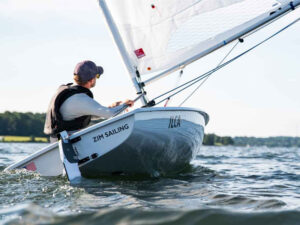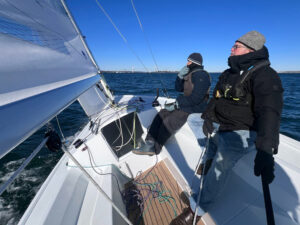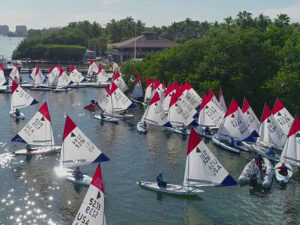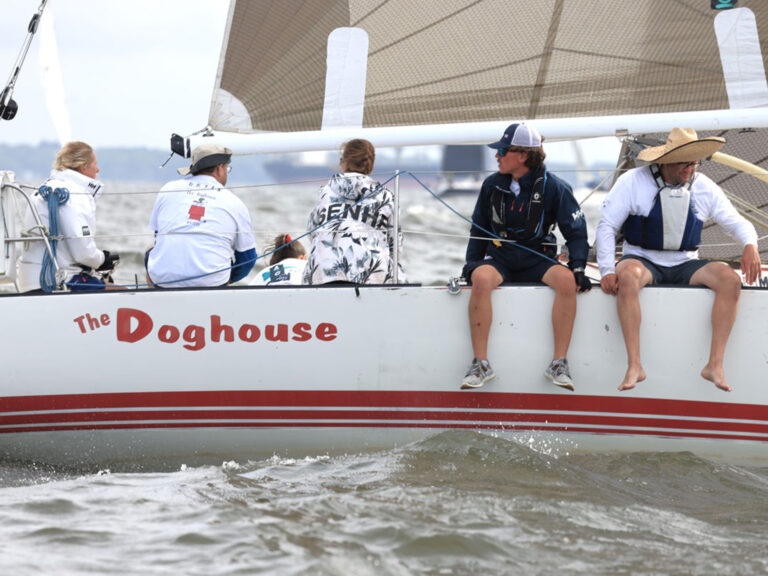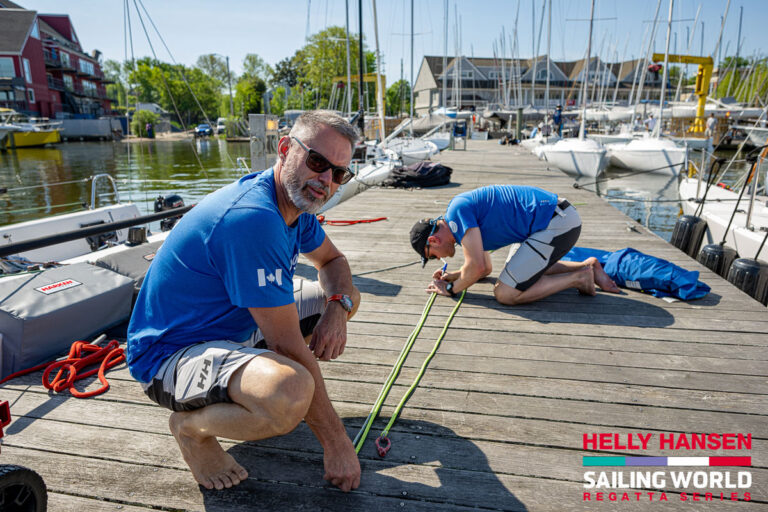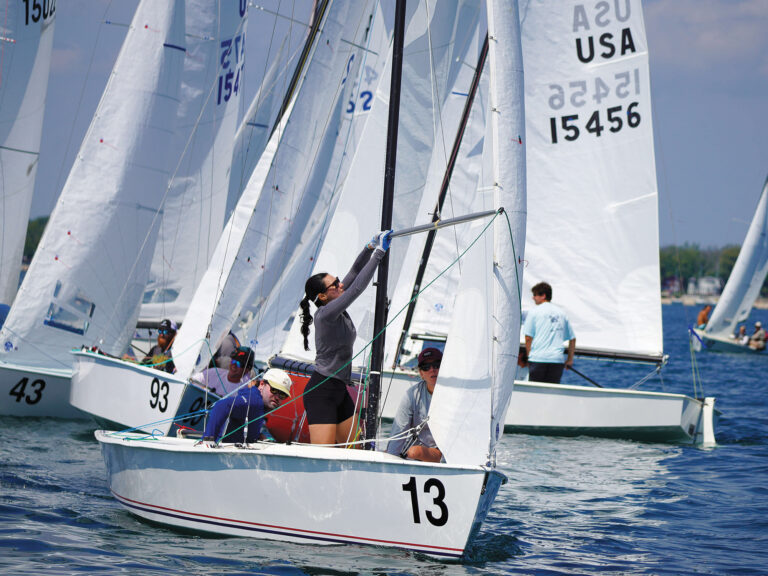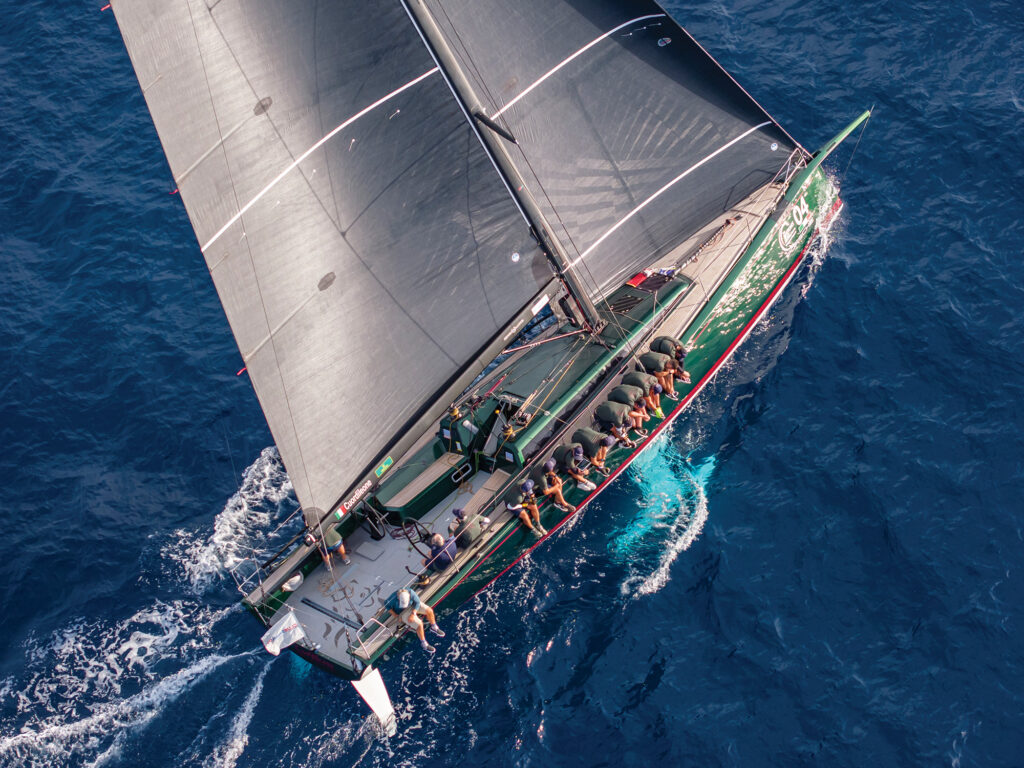
It’s the golden hour in Mallorca, and the late-October setting sun bathes the magnificent Palma Cathedral in electric orange. We’re cruising back to the harbor under mainsail and motor as the Cuordileone sailing team flakes the jib into its bag and strips spinnaker sheets. Fashion magnate Leonardo Ferragamo—the boat’s owner and helmsman, and soul of the modern-day Nautor Swan brand—has disappeared belowdecks. The third race of the afternoon was a true test of Ferragamo’s concentration.
As a media guest restricted to the back of the boat on the opening day of the Swan One Design World Championships, I can attest that buoy racing ClubSwan 50s loaded with pro sailors and owner-drivers is indeed mentally taxing. If I were Ferragamo, I too would head straight to the aft cabin.
“Does he go down and take a nap?” I ask the team’s tactician, Álvaro Marinho, a two-time Olympic 470 sailor from Portugal.
“Oh, no, phone calls,” Marinho answers. “Mr. Ferragamo is always on the phone. Many businesses.”
One of Ferragamo’s ventures is, of course, the Nautor Swan universe, which he has led since 1998, ushering in the Italian era of sailing’s most enduring yacht brand. In the years since, Nautor Swan has assumed an entirely different look and feel. Gone are the stout and heavy IOR hangovers of yore. In are the sexier and faster shapes prevalent in race boats today. The yesteryear Swan regime aligned with the greats of German Frers and Sparkman & Stephens. Today, it’s Juan K and design houses that work their magic with sophisticated tools. There are now gigantic Swan Maxis that stretch well past 100 feet, and all sorts of bold concepts: daggerboards on the ClubSwan 36, for example, or the tubercle rudders on the ClubSwan 50. Which is all to say that Nautor Swan and its new majority shareholder, the Sanlorenzo Group, are charging forward with innovation. We just don’t see it here in the US.
It’s not all big boats, though. Well below the 70- and 80-footers, they’ve recently launched the ClubSwan 28 as the “entry to the ClubSwan Racing world,” as well as the ClubSwan 43 crossover, released back-to-back over the past two years. Building and launching new models is one thing, but there’s also been a greater emphasis on building a desire to belong.
That’s where the whole ClubSwan thing comes into the conversation. To own a slick boat is one thing; to be part of the club is another. Creating a deeper owner connection requires extra effort and resources beyond the sales contract, and this is where many boatbuilders today lose the plot. Rendezvous, regattas, and extraordinary class championships in Palma and other ports of the Med is Nautor’s way of tying it all together. And it’s working.
When I get the chance to see it for myself, it’s obvious that Swan pride is abundant on the docks in Palma for the three-class world-championship event. Present are a dozen top-end ClubSwan 50 programs, 10 ClubSwan 36s lined up Med-style to the Real Club Nautico de Palma’s bulwark, and a fleet of now-ancient ClubSwan 42s, a model that’s no longer in production but still plenty active in Europe as an ORC weapon. The CS50 programs have their containers in the parking lot. The 42 teams have their gear and sails piled in chest-high portable dock boxes. Corporate-sponsor logos are omnipresent, but for the most part, affluent private owners and their sailing teams are the ones racking up tabs at the club. Matching team gear is definitely a thing.
As we wait for wind on the first day, there’s the typical scene of sail tending, grazing, friendly banter and idle boatwork. And here among the activity I meet Federico Michetti, an Italian sailor with a dozen world-championship titles. He’s relatively new to the Nautor Swan team, assigned with a broad title of sport director.
Michetti’s role within the company was created a few years ago in order to create greater cohesion and community among owners and its nascent classes, which primarily pull owners from Northern Europe and the Med. As Michetti says, “We take care of all the racing around the world, which, with more than 2,000 boats around the world, is significant, because in every marina, there is a Swan.”
This One Design Worlds is the pinnacle event of a long season of racing in amazing locations, he says. “There are other circuits for owner-drivers, but what makes us special is that while the competition is important, all the other aspects related to the activities, the parties and the social are equally important. Connecting to owners is vital for the glamour that comes with being a Swan owner.”
Only one person goes home with a trophy, he adds, so everyone else has to leave with a greater sense of belonging to something amazing.
When the AP flag finally lowers after a long morning postponement, I’m jettisoned to the guest spot on board the ClubSwan 50 Olymp, with Mark Bezner, a relatively new owner, and his tactician-for-hire, Jochen Schümann, the great German Olympian and coach to the stars. On the motor out to the race area, Schümann shares that he was responsible for developing the ClubSwan 50 class rules and knows well the delicate balance of making the unattainable attainable in a grand-prix world where owners with bottomless budgets get burned out and ego-driven pros forget that their primary job is to make the owner happy. The “club” concept ensures that doesn’t happen.
As we follow the race-committee boat while they search for the ideal place to set a course, I’m told that I will be taken off the boat and shuttled to Cuordileone, the dark-green boat of Ferragamo. His guest had canceled at the last minute, and he needs one more person to remain weight-compliant.
I climb on board from an umpire RIB that has been commandeered to transfer me, and am greeted by Michetti, who introduces me to a few of the sailors. Italian is the official language of the crew, and I quickly sense it’s a tight-knit squad of Ferragamo’s regulars: a few veterans at the back of the boat pulling on the big ropes and the young ones up front in charge of everything else.
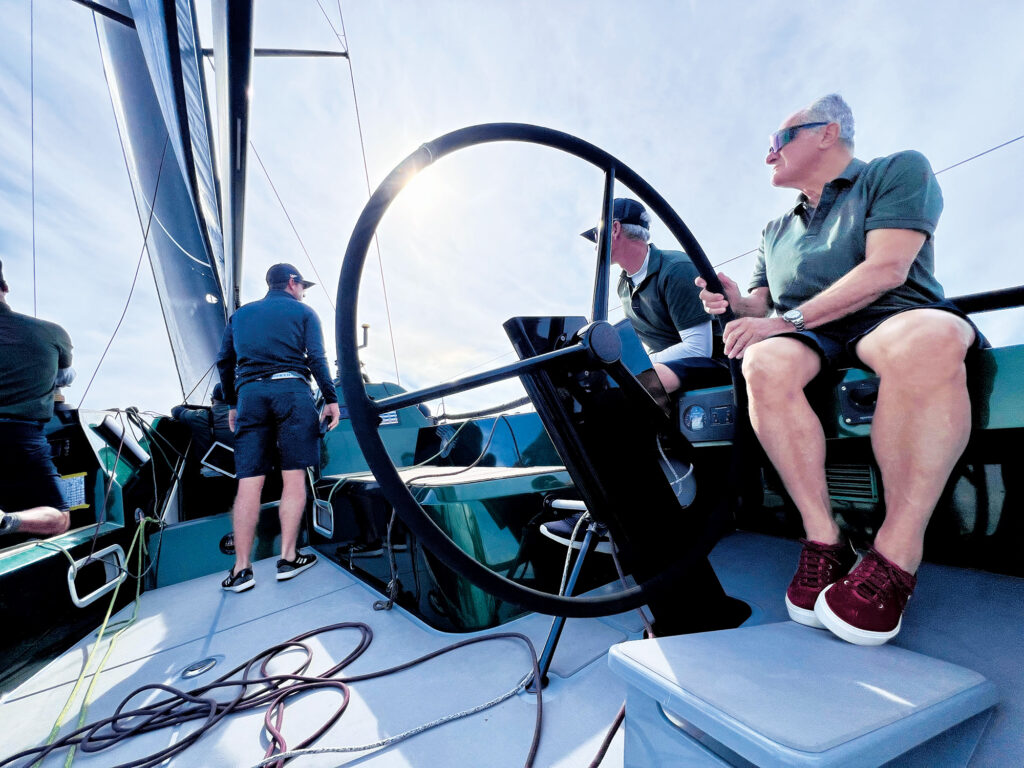
The headsail goes up, and we’re off on an upwind course. Eventually, Ferragamo emerges from the companionway and gingerly steps to the starboard steering wheel, puts his phone into his coat pocket, adjusts his sunglasses, and stares intently ahead. He’s regal, tall and slender—and in his element.
After pinging the ends of the starting line, we’re soon into the sequence, and Marinho’s intensity elevates as we sail below the starboard herd on port tack. Near the boat end of the line, we tack with 30 seconds to go. I can see exactly what he’s setting up for. He wants the boat, but there’s already a big pileup of 50-footers hovering and waiting. This will be interesting.
We’ve all been there: It starts with hope, then comes the urgency to slow for a last-minute opening. There’s no stopping our momentum, and in a blink, our bow is feet from impact, but Marinho knows when to give up and guides Ferragamo away from disaster.
The second row will have to do, and we’re promptly clearing out to the right, bouncing between boats and clear lanes until we’re near the top of the course, where the entire fleet compresses. We cross one boat, then tack on the lee bow of another. Not laying, we tack again inside the three-length zone, charging toward a pair of boats on the starboard layline.
Oh, this is going to be good, I think, and reach for my iPhone to capture the moment of chaos. Marinho leaps to the leeward cockpit coaming and stares down the starboard tacker’s tactician, who has eyes locked on us. Marinho gives a few rotations of his extended thumb, up and down, as if to ask whether to tack or cross ahead. He gets no response, and with feet to spare, Ferragamo turns the wheel hard to avoid a collision. There’s no more than a foot between the starboard boat’s bowsprit and our stern. The umpires are watching, and there’s no flag or whistle. My heart is racing, but Ferragamo is icy-cool, as if he’s done this plenty of times.
Downwind and upwind, we go again on a few more laps to somehow finish this race third. Ferragamo disappears below until the next race, and the pattern repeats itself twice more, with three top-five finishes.
As we near the harbor entrance, Marinho assembles everyone in the cockpit for the debrief. Ferragamo eventually comes on deck, puts away his phone, and settles in among the crew. For 10 minutes, Marinho shares his thoughts, some of which I can translate. There’s discussion about target boatspeeds and Ferragamo’s wanderings away from them. There’s something about a communication breakdown from the back of the boat to the front of the boat that resulted in rushed maneuvers, and I think a confession from Marinho that he needs to dial down his intensity.
I don’t know what they’re saying, exactly, but it’s all fundamentals: Stay on target, communicate early and clearly, relax, and have fun. It’s a sailboat race. We’re in Palma, and we’re in the Club, so enjoy it.

